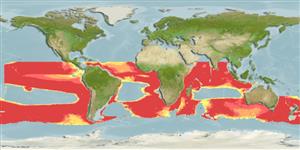Environment: milieu / climate zone / depth range / distribution range
экология
морской батипелагический; пределы глубины 1000 - 3300 m (Ref. 75596), usually 1400 - 2500 m (Ref. 75596). Deep-water; 16°N - 60°S (Ref. 75596)
Circumglobal in equatorial, tropical, subtropical, temperate and subpolar regions: Atlantic Ocean (40° N to 40° S); Indian Ocean (from the type locality, 16°56’ N, 92°33’ E); Pacific Ocean (31° N to 43° S); Southern Ocean (50° S-60° S).
Size / Вес / Возраст
Maturity: Lm ? range ? - ? cm
Max length : 26.2 cm SL самец/пол неопределен; (Ref. 6944)
колючие лучи спинного плавника (общее число): 11 - 14; членистые (мягкие) лучи спинного плавника (общее число): 21-25; колючие лучи анального плавника 1; членистые (мягкие) лучи анального плавника: 22 - 26. This species is distinguished from its congeners K. falx by the teeth in lateral series of premaxilla 7-11, caniniform, elongated, slightly curved, type 4, widely spaced (vs. teeth in lateral series of premaxilla 13-33; recurved, with ventral attachment, closely spaced in K. parri; needle-like, closely spaced in K. kerberti and K. macrodon and anterior part fourth of K. normani; caniniform but not very elongated in K. colubrina); first tooth of lateral series of premaxilla longest, with tight type 4 attachment (vs. first tooth of lateral series of premaxilla not remarkably enlarged, smaller than adjacent teeth, with loose types 4 attachment or with ventral attachment to bone); teeth in mesial series of premaxilla 3, fang-like (vs. 4 or 15; not fang-like in K. macrura, K. parri, K. colubrina); teeth in lateral series of dentary 6-8, very elongated, curved, type 4, widely spaced (vs. 12-32; recurved, with ventral attachment, closely spaced in K. parri, needle-like, closely spaced in K. kerberti and K. macrodon and anterior part fourth of K. normani; recurved in K. colubrina). This species can be further distinguished from K. falx by the larger eye, orbit width 15.4-22.7% and orbit height 12.5-18% in head length (vs. eye small, orbit width 11.2-16.0% and orbit height 9.7-12.4% in head length); basihyal elongated and straight, pointing forward (vs. basihyal reduced, strongly curved, pointing ventrally); first tooth in lateral series of premaxilla enlarged, 15.2-16.4 % in premaxillary length, slightly curved, not projecting anteriorly (vs. first tooth remarkably enlarged, 17.2-20.5% in premaxillary length, sickle-shaped, projecting anteriorly); first tooth in mesial series of premaxilla anterior to level of anterior nostril, and to second tooth of lateral series (vs. first tooth below level of anterior nostril, and beside second tooth of lateral series); first tooth in mesial series of dentary beside second tooth of lateral series (vs. first tooth between second and third teeth in lateral series) (Ref. 75596).
The shallowest depth record is based on a single Gargaropteron-staged individual which was taken in the Yucatan Channel, in 0-124 m (Museum: RHB 1290).
Life cycle and mating behavior
половая зрелость | размножение | нерест | икра | Fecundity | личинки
Melo, M.R.S., 2008. The genus Kali Lloyd (Chiasmodontidae: Teleostei) with description of new two species, and the revalidation of K. kerberti Weber. Zootaxa 1747:1-33. (Ref. 75596)
Статус Красного Списка МСОП (Ref. 130435)
Угроза для людей
Harmless
Использование человеком
рыболовство: интереса не представляет
дополнительная информация
народные названиясинонимыобмен веществхищникиэкотоксикологияразмножениеполовая зрелостьнерестSpawning aggregationFecundityикраРазвитие икры
ссылкиаквакультура (рыбоводство)особенности рыбоводствастепень растяжениягенетикаElectrophoresesнаследуемостьболезниобработкаNutrientsMass conversion
соавторыизображенияStamps, Coins Misc.звукиCiguateraскоростьтип плаванияжаберная областьOtolithsмозгзрение
инструменты
Специальные отчеты
Скачать в формате XML
ресурсы в Интернет
Estimates based on models
Preferred temperature (Ref.
123201): 1.8 - 4.2, mean 2.5 °C (based on 2804 cells).
Phylogenetic diversity index (Ref.
82804): PD
50 = 0.5078 [Uniqueness, from 0.5 = low to 2.0 = high].
Bayesian length-weight: a=0.00389 (0.00180 - 0.00842), b=3.12 (2.94 - 3.30), in cm total length, based on all LWR estimates for this body shape (Ref.
93245).
Trophic level (Ref.
69278): 3.8 ±0.2 se; based on size and trophs of closest relatives
Fishing Vulnerability (Ref.
59153): Low vulnerability (22 of 100).
